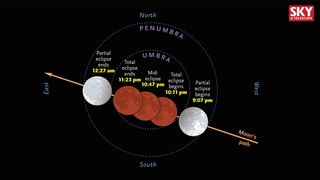Why Tonight's Full Moon Is a 'Harvest Moon' Lunar Eclipse

The full moon tonight (Sept. 27) will be an especially special lunar occasion. In addition to being a traditional "harvest moon," the moon will be at its closest point to Earth in its orbit, making it a so-called "supermoon." Plus, skywatchers people across North and South America, Europe and Africa will get to see a lunar eclipse, because the moon will pass into the Earth's shadow.
You can watch the harvest moon lunar eclipse live in a webcast by the Slooh Community Observatory. You can also watch the total lunar eclipse on Space.com, courtesy of Slooh.
But why does tonight's full moon called a harvest moon? Traditionally, the harvest moon is the name that is assigned to the full moon that falls closest to the autumn equinox, which occurred on Sept. 23. (Technically speaking, it's autumn in the Northern Hemisphere and spring in the Southern Hemisphere). [Tonight's Total Lunar Eclipse: When and How to See It]

The equinox occurs when the sun crosses the celestial equator. At that time, most points on the Earth have almost exactly even proportions of day and night — 12 hours each.
Besides astronomical events, however, fall signals a time to reap the crops that have been grown all summer. That's why it is called a harvest moon.
"Corn, pumpkins, squash, beans and wild rice — the chief Indian staples — are now ready for gathering," Space.com's skywatching columnist Joe Rao wrote in an article about the full moon names of 2015.
The harvest moon is also sometimes called the "corn moon," too.
Get the Space.com Newsletter
Breaking space news, the latest updates on rocket launches, skywatching events and more!
"At the peak of the harvest, farmers can work into the night by the light of this moon," Rao added in a 2013 article about the moon names. "Usually the moon rises an average of 50 minutes later each night, but for the few nights around the Harvest Moon, the moon seems to rise at nearly the same time each night: just 25 to 30 minutes later across the U.S., and only 10 to 20 minutes later for much of Canada and Europe."
Editor's Note: If you snap an amazing picture of the September 27 total lunar eclipse, you can send photos, comments and your name and location to managing editor Tariq Malik at spacephotos@space.com.
Follow Elizabeth Howell @howellspace, or Space.com @Spacedotcom. We're also on Facebook and Google+. Original article on Space.com.
Join our Space Forums to keep talking space on the latest missions, night sky and more! And if you have a news tip, correction or comment, let us know at: community@space.com.

Elizabeth Howell (she/her), Ph.D., is a staff writer in the spaceflight channel since 2022 covering diversity, education and gaming as well. She was contributing writer for Space.com for 10 years before joining full-time. Elizabeth's reporting includes multiple exclusives with the White House and Office of the Vice-President of the United States, an exclusive conversation with aspiring space tourist (and NSYNC bassist) Lance Bass, speaking several times with the International Space Station, witnessing five human spaceflight launches on two continents, flying parabolic, working inside a spacesuit, and participating in a simulated Mars mission. Her latest book, "Why Am I Taller?", is co-written with astronaut Dave Williams. Elizabeth holds a Ph.D. and M.Sc. in Space Studies from the University of North Dakota, a Bachelor of Journalism from Canada's Carleton University and a Bachelor of History from Canada's Athabasca University. Elizabeth is also a post-secondary instructor in communications and science at several institutions since 2015; her experience includes developing and teaching an astronomy course at Canada's Algonquin College (with Indigenous content as well) to more than 1,000 students since 2020. Elizabeth first got interested in space after watching the movie Apollo 13 in 1996, and still wants to be an astronaut someday. Mastodon: https://qoto.org/@howellspace
Most Popular



